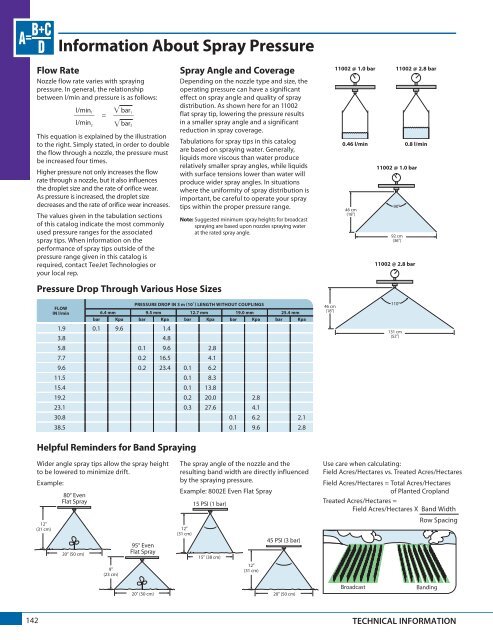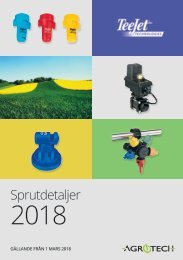TeeJet produktkatalog 51A-M
TeeJet Technologies produktkatalog med sprutdetaljer och elektronik för lantbruk.
TeeJet Technologies produktkatalog med sprutdetaljer och elektronik för lantbruk.
Create successful ePaper yourself
Turn your PDF publications into a flip-book with our unique Google optimized e-Paper software.
Information About Spray Pressure<br />
Flow Rate<br />
Nozzle flow rate varies with spraying<br />
pressure. In general, the relationship<br />
between l/min and pressure is as follows:<br />
______ l/min 1<br />
= ______ bar 1<br />
l/min 2 bar 2<br />
This equation is explained by the illus tration<br />
to the right. Simply stated, in order to double<br />
the flow through a nozzle, the pressure must<br />
be increased four times.<br />
Higher pressure not only increases the flow<br />
rate through a nozzle, but it also influences<br />
the droplet size and the rate of orifice wear.<br />
As pressure is increased, the droplet size<br />
decreases and the rate of orifice wear increases.<br />
The values given in the tabulation sections<br />
of this catalog indicate the most commonly<br />
used pressure ranges for the associated<br />
spray tips. When information on the<br />
performance of spray tips outside of the<br />
pressure range given in this catalog is<br />
required, contact <strong>TeeJet</strong> Technologies or<br />
your local rep.<br />
Spray Angle and Coverage<br />
Depending on the nozzle type and size, the<br />
operating pressure can have a significant<br />
effect on spray angle and quality of spray<br />
distribution. As shown here for an 11002<br />
flat spray tip, lowering the pressure results<br />
in a smaller spray angle and a significant<br />
reduction in spray coverage.<br />
Tabulations for spray tips in this catalog<br />
are based on spraying water. Generally,<br />
liquids more viscous than water produce<br />
relatively smaller spray angles, while liquids<br />
with surface tensions lower than water will<br />
produce wider spray angles. In situations<br />
where the uniformity of spray distribution is<br />
important, be careful to operate your spray<br />
tips within the proper pressure range.<br />
Note: Suggested minimum spray heights for broadcast<br />
spraying are based upon nozzles spraying water<br />
at the rated spray angle.<br />
11002 @ 1.0 bar<br />
0.46 l/min<br />
46 cm<br />
(18)<br />
90º<br />
0.8 l/min<br />
11002 @ 1.0 bar<br />
11002 @ 2.8 bar<br />
11002 @ 2.8 bar<br />
92 cm<br />
(36)<br />
Pressure Drop Through Various Hose Sizes<br />
FLOW<br />
IN l/min<br />
1.9 0.1 9.6 1.4<br />
3.8 4.8<br />
PRESSURE DROP IN 3 m (10) LENGTH WITHOUT COUPLINGS<br />
6.4 mm 9.5 mm 12.7 mm 19.0 mm 25.4 mm<br />
bar Kpa bar Kpa bar Kpa bar Kpa bar Kpa<br />
5.8 0.1 9.6 2.8<br />
7.7 0.2 16.5 4.1<br />
9.6 0.2 23.4 0.1 6.2<br />
11.5 0.1 8.3<br />
15.4 0.1 13.8<br />
19.2 0.2 20.0 2.8<br />
23.1 0.3 27.6 4.1<br />
30.8 0.1 6.2 2.1<br />
38.5 0.1 9.6 2.8<br />
46 cm<br />
(18)<br />
110º<br />
131 cm<br />
(52)<br />
Helpful Reminders for Band Spraying<br />
Wider angle spray tips allow the spray height<br />
to be lowered to minimize drift.<br />
Example:<br />
12<br />
(31 cm)<br />
80° Even<br />
Flat Spray<br />
20 (50 cm)<br />
9<br />
(23 cm)<br />
95° Even<br />
Flat Spray<br />
The spray angle of the nozzle and the<br />
resulting band width are directly influenced<br />
by the spraying pressure.<br />
Example: 8002E Even Flat Spray<br />
12<br />
(31 cm)<br />
15 PSI (1 bar)<br />
15 (38 cm)<br />
12<br />
(31 cm)<br />
45 PSI (3 bar)<br />
Use care when calculating:<br />
Field Acres/Hectares vs. Treated Acres/Hectares<br />
Field Acres/Hectares = Total Acres/Hectares<br />
of Planted Cropland<br />
Treated Acres/Hectares =<br />
Field Acres/Hectares X Band Width<br />
Row Spacing<br />
20 (50 cm)<br />
20 (50 cm)<br />
Broadcast<br />
Banding<br />
142<br />
TECHNICAL INFORMATION




